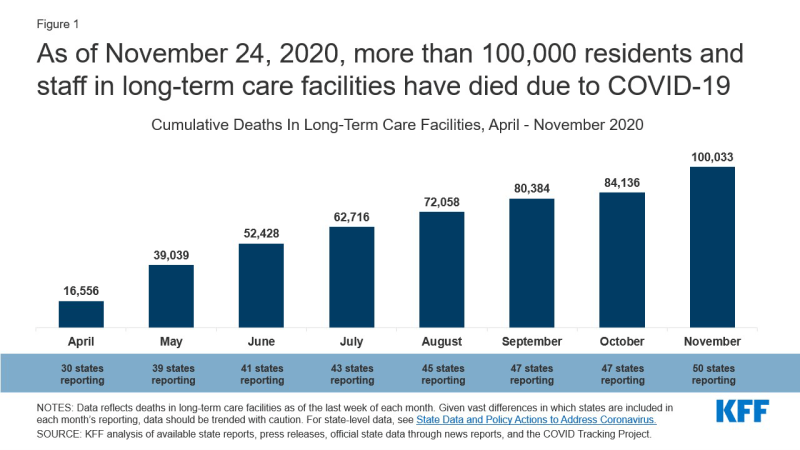COVID-19 Has Claimed the Lives of 100,000 Long-Term Care Residents and Staff
Priya Chidambaram, Rachel Garfield, and Tricia Neuman
Published:
This week marks a bleak milestone in the pandemic’s effect on residents and staff in long-term care facilities across the country. According to our latest analysis of state-reported data, COVID-19 has claimed the lives of more than 100,000 long-term care facility residents and staff as of the last week in November. This finding comes at a time when public health experts are predicting a surge in cases after holiday gatherings and increased time indoors due to winter weather, which will have ripple effects on hospitals and nursing homes, given the close relationship between community spread and cases in congregate care settings. As the nation braces for the fallout of the holiday, recent data on deaths in long-term care facilities highlight the ongoing disproportionate impact on this high-risk population.

As of November 24, 2020, more than 100,00 residents and staff in long-term care facilities have died due to COVID-19
Since the start of the pandemic, 100,033 residents and staff at long-term care facilities have died from COVID-19 as of November 24, 2020, according to state reporting in 49 states plus DC (Figure 1). This is likely an undercount, given that five states have not updated their long-term care death values in over one week (HI, ME, MO, NE, and WV) and Alaska still does not provide data on deaths in these facilities. Figure 1 depicts the increase in long-term care deaths since the start of the pandemic. The increase reflects both an increase in deaths and an increase in the number of states reporting over time. Given the vast differences in state reporting between April and November, data in Figure 1 should be trended with caution. See Data Notes below for more details on this increase in deaths.
Nationwide, deaths in long-term care facilities account for 40% of all COVID-19 deaths. In 18 states, COVID-19 deaths in long-term care facilities account for at least half of all deaths due to the pandemic (NH, RI, CT, MN, KY, PA, MA, NE, ME, ND, OH, DE, WA, OR, IN, VT, MD, NC). In three states, long-term care COVID-19 deaths account for over 70% of COVID-19 deaths in the state (NH, RI, and CT). Many states have consistently reported a high burden of COVID-19 deaths in long-term care facilities, with Minnesota, Rhode Island, and New Hampshire consistently reporting among the highest shares of COVID-19 deaths in long-term care facilities. See Data Notes below for more details on the share of COVID-19 deaths in long-term care facilities.
While early action to prevent the spread of coronavirus in long-term care facilities led to strict protocols related to testing, personal protective equipment (PPE), and visitor restrictions, several of these measures have been reversed in recent months, and some long-term care facilities continue to report shortages of PPE and staff. The disproportionate number of COVID-19 deaths in long-term care facilities serves as a reminder that residents and staff in these places continue to bear a high burden of the uncontrolled pandemic. Post-Thanksgiving surges in cases are unlikely to spare this community and will likely lead to an even higher death toll in long-term care facilities, raising questions about whether nursing homes and other facilities are able to protect their residents and, if not, what actions can be taken to mitigate the threat posed by the virus.
Data Notes
The number of states independently reporting long-term deaths due to COVID-19 has increased from 30 states in April to 50 states (all but Alaska) in November, which suggests that the total number of deaths reported in the first few months of the pandemic is an undercount. States also vary widely in how they report COVID-19 deaths. For example, some states include assisted living and other residential facilities in their total counts, while others limit their counts to nursing facilities. For more details on what states may include or exclude in their long-term care data reporting, see Table 3 in Key Questions About the Impact of Coronavirus on Long-Term Care Facilities Over Time.
Data reported by nursing facilities to the Centers for Disease Control and published by the Centers for Medicare and Medicaid Services is more consistent across states but may not consistently include data prior to May 8th and only include federally certified nursing facilities. For more details on the limits and opportunities of federal reporting, see KFF brief here.
For state-level data on share of deaths occurring in long-term care facilities, see our long-term care data at State Data and Policy Actions to Address Coronavirus. Shares of COVID-19 deaths occurring in long-term care facilities should not be used to compare states since not all states report COVID-19 long-term care facility deaths the same way. For example, New York, unlike other states, does not include deaths among nursing home residents that occur outside of the nursing home (e.g., if the death occurs in the hospital) in its long-term care death count.
